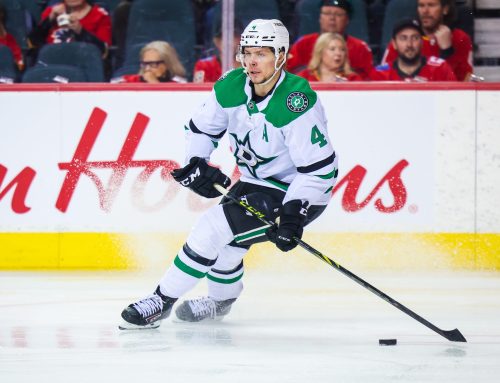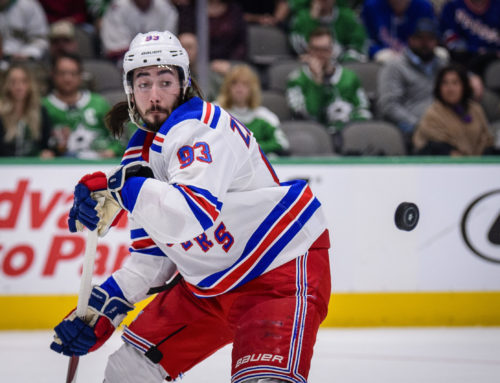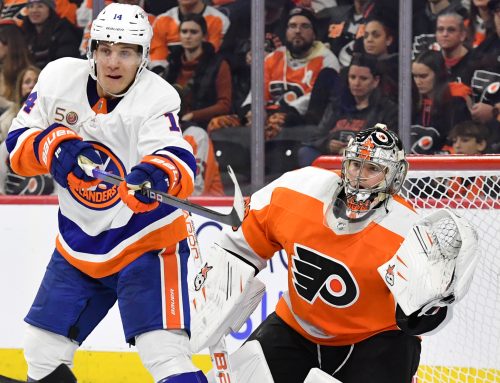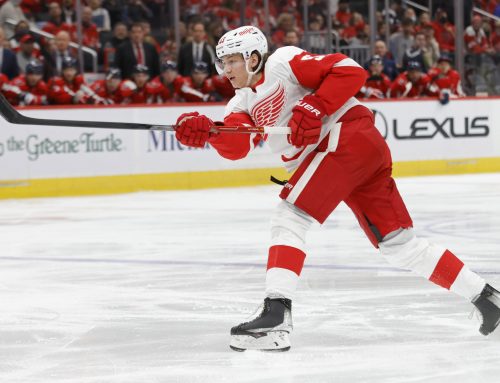Goldipucks and the Three Skaters: Seth Jarvis, Mat Barzal & Josh Morrissey
Rick Roos
2024-04-03
Welcome back to Goldipucks and the Three Skaters, a play on words of the Goldilocks and the Three Bears story. Instead of there being three bowls of porridge though, I cover three skaters and declare one too hot (i.e., doing unsustainably better than he should), another too cold (i.e., doing unsustainably worse), and a third “just right” (i.e., producing where he should be). In addition, I also assign each a rating of 1-10, indicating how hot (rated 7-10, where 10 is the most unsustainably hot), cold (rated 1-4, where 1 is the most unsustainably cold), or “just right” (rated 4-7, where 5.5 is the most “just right”) he is.
As each skater's games played total rises, so too does the temptation to "trust the numbers". After all, in many cases it's 70+ games worth of data. But if there's a motto of this column, it's that looks can be deceiving, masking trends that suggest the player is too hot or too cold, while in other cases the numbers do indeed tell the real story. For this edition of Goldipucks your task is to figure out which of those labels belongs to Seth Jarvis, Matthew Barzal, and Josh Morrissey. To get the most out of this, be sure to stop reading now, make predictions for each player, and then read on to find out if you nailed all three. Stats for all three players are current through March 29th.
Seth Jarvis (74 GP, 28 G, 32 A, 163 SOG, 18:49 TOI, 17 PPPts, 2:59 PP, 62.8% PP%)
Grabbed by the Canes 13th overall in 2020, Jarvis started the campaign in the WHL but made it to the AHL, where he posted better than point per game numbers. It was therefore no surprise to see him in Carolina to stay for 2021-22. And his impact was felt as a rookie, with a 48-point scoring pace but ending the season with 12 points in as many games. Yet hopes for him to carry that momentum into 2022-23 did not come to fruition, as Jarvis failed to reach point per every other game scoring. For 2023-24, however, he's doing the best he has as yet, coinciding with his 200-game breakout threshold. Is he hitting his stride, such that even better things likely will come in 2024-25? Not from what I'm seeing; in fact, he seems likely to do worse.
Clearly Jarvis had bad luck last season in shooting a paltry 5.5%. Yet for 2023-24 he's above his rookie percentage at 17.2%. Although 31 forwards have played 40+ games and sport a higher SH% than Jarvis, only eight have taken more shots. A lot of that has to do with Jarvis somehow having managed to score nine goals on his last 26 shots, which of course is not even close to a sustainable rate.
Also, Jarvis has 11 PPGs on just 49 PP SOG. Of the 18 forwards with more PPGs than him, just one has fewer PP SOG, with more than half having 20 more PP SOG than him. It's safe to say that Jarvis might have potted at least a handful more goals, overall and at ES, than he should've in the normal course.
Jarvis also is far from a points magnet, demonstrated by subpar IPPs. As a rookie, Jarvis had IPPs of 70%+ both overall and on the PP, which made me feel – at the time – he was headed for success. Since then his IPPs have been lousy, at 35.7% on the PP last season, and 43.6% so far for 2023-24, while overall last season it was 54.2% and for 2023-24 it's 57.1%. Although not every goal has two assists attached to it, the majority do, meaning there are usually three points up for grabs. Although forwards comprise 60% of those on the ice at 5×5, meaning a 60% IPP should be the mathematical norm for a forward, really it ought to be even higher, as d-men should not factor into scoring as frequently as forwards.
Seeing Jarvis with a sub-60% IPP last season and being on the verge of the same for the 2023-24 campaign yet again is very discouraging. In fact, of the more than 100 forwards who've played in 40+ games and have a lower IPP, just Ryan-Nugent Hopkins and Zach Hyman have more points, and their IPPs are of course brought down by them sharing the ice at ES and/or on the PP with Leon Draisaitl and Connor McDavid. Jarvis though does not have a similar excuse, which is quite concerning.
It seems that Jarvis is a passenger who's lucked into more goals than he should've. How do his other metrics look though? His 5×5 team shooting percentage is 10.9%, which normally would be very encouraging; however, it's unlikely to go much higher and Jarvis isn't generating those points. Also, his secondary assist rate of 43.8% is certainly not high, but also not so low as to suggest more points should come in the normal course.
The other cause of concern is Carolina is stacked at forward. Although it is quite possible Jake Guentzel and/or Teuvo Teravainen will opt to leave as UFAs at the end of the season, if they do, chances are one or both will get replaced with comparable talent. There is already Sebastian Aho, Martin Necas, Andrei Svechnikov, the seemingly reborn Evgeny Kuznetsov and even Jesperi Kotkaniemi in the mix who are all inked through at least next season. That is stiff competition for a spot on PP1, such that Jarvis' low IPP with the man advantage might earn him a ticket to the second unit, which would cut into his already not great PP scoring, as he has a mere six PP assists to go with his 11 PPGs.
Jarvis is, as noted, just hitting his breakout threshold; however, looking at his metrics it is one piece of bad news after another. He's a passenger, not a creator of offense, with a SH% that's too high, and IPPs that are too low. He also is on a team with no shortage of other options on which to bestow top ice time. As such, Jarvis' 2023-24 has been TOO HOT, and he gets a rating of 8.25, as he seems to be more of a 55- to 60-point player as opposed to what we're seeing from him now.
Mathew Barzal (71 GP, 23 G, 515 A, 212 SOG, 20:03 TOI, 24 PPPts, 3:10 PP, 68.8% PP%)
Drafted 16th overall in 2015, Barzal somewhat surprisingly spent two more seasons in juniors. After playing just two games for the Isles in 2016-17, he was given the chance to make the everyday NHL roster in 2017-18. To say that he seized upon that opportunity would be a vast understatement, as he tallied a jaw-dropping 85 points at just age 20, setting the bar very high in terms of future expectations. Since then though, Barzal has been in a purgatory of sorts, playing in defense-first systems and, in turn, not even coming close to meeting, let alone building upon, his rookie scoring rate. This season though he's come back alive. Is he at the level where he should be? No, but only because he's poised to do even better.
Right off the bat we can see that Barzal's SOG rate per game is 3.0, which is not only easily a career best, but well higher than the 2.1 per game it was as a rookie and scoring at a similar pace. But his SH% is right at his career average, signifying that although he's shooting more it's not in the form of low quality shots. Interestingly, no one with more PPPts than Barzal has fewer PP SOG, as he's averaging barely one per every other game, this after averaging two every three games last season. There's realistic room for him to take even more PP SOG, and, with that, for his PP scoring to rise in the normal course.
What's also interesting is no forward with more points has fewer games with 2+ points; and in fact, Barzal's 17 multipoint games is three less than the next lowest, other than Sidney Crosby, who has 18. But Barzal's 69.0% of games with at least one point puts him ahead of all but one of the players with up to eight more points than him. Barzal is consistent, but not explosive. Or is he? He does have three games with four points, which I read as Barzal having potent talent but not being helped by those around him. That can only improve.
One thing about Barzal that has been a constant is his overall IPP, which, in each and every season of his NHL career has been 71.0% or higher. That is no easy feat to accomplish, even when, admittedly, some of those seasons Barzal was the only thing close to an offensive talent, so it stood to reason that his IPP would be high. But for it to be above that key 70% threshold every single season is truly amazing. And even as his scoring has increased this season, as, finally, he has talent around him, it once again stands above that same threshold at 71.8%. Simply put, he's a points magnet and an offensive catalyst.
Less surprising is that his secondary assist percentage has never been above 50%. While that is unusual for a center, the lack of talent which had surrounded Barzal made it that for him to get a point it usually was him scoring a goal or making a pass that directly led to a goal. Yet this season his rate somehow is on pace for a career low of 33.3%. And of his 17 secondary assists, all but three have come on the PP, meaning he has an astonishing 28 primary even strength assists, which puts him third among all forwards, and a mere four secondary even-strength assists, with the two who have more primary assists having 22 and 20. This only serves to reinforce that Barzal is a points magnet and has the very real capacity to get many, many more secondary assists in the normal course.
Interestingly though, even as he's thriving this season his 5×5 team SH% only 8.2%. There too I chalk it up to lack of comparable talent, and a testament to his skill to be able to still score as much as he has. Also, he's scoring more despite a somewhat low team SH% due to more shooting occurring by him and, presumably, those with whom he shares the ice, such that it doesn't take as high a SH% to still lead to an upped number of goals.
I think if Barzal had been put into more offensive-friendly environments and had better teammates, there's a good chance he could've already have at least one 100+ point season. He's that great. As it stands though, while the Islanders are not the same offensively-stiffing team they've been for many years, they're still a far cry from a powerhouse. And yet despite this, Barzal is back above the point per game level. The data for Barzal paints a clear picture that his 2023-24 has been TOO COLD, and he gets a rating of 1.25, as I feel Patrick Roy will allow this team to open things up even more next season, and this might be the last time we see Barzal below a 90-point scoring pace, with a better shot at rising to 95 than falling to 85.
Josh Morrissey (73 GP, 8 G, 50 A, 183 SOG, 24:17 TOI, 14 PPPts, 3:17 PP, 65.0% PP%)
Like Jarvis, Morrissey was drafted 13th overall, but he wasn't with the Jets to stay until age 21. Things were going well, as his scoring rate went from 20, to 26, to 43. Then he stalled, making some wonder if this was the best we'd see. All that changed last season, when his scoring spiked to 76 points in 78 games. But although his explosion coincided with his 400-game breakout threshold, many were skeptical. For 2023-24, his scoring has come back to earth somewhat. Can he rise back to 2022-23 levels? Or is this the start of a downward trend? Neither, as it appears his 2023-24 production rate is sustainable for the most part.
Let's first look at 2022-23, to see how "real" his output was. His overall SH% was 9.3%, after never shooting even 7.0%. Also, he had 28 PPPts, or greater than one per every three games, after only once – and barely – averaging one per every five games in a prior season. Sure enough, his 2022-23 PP IPP was 66.7%. Granted, Morrissey had the same PP IPP earlier in his career, and another time had a PP IPP of 92.3%. The distinction was in those seasons he was not on PP1, meaning he wasn't on the ice with the best of the best in terms of Jet forwards like he was last season and is now. In fact, the prior two instances where he took the ice for even above 50% of available PP minutes, his PP IPPs were 55.6% and 56.3%. For him to climb to 66.7% when he was on the ice for, coincidentally, 66.7% of his team's PP minutes, does raise eyebrows. But even more concerning was his overall IPP in 2022-23 of 58.0%, after never once having been even 41%. No question Morrissey tallied points at a rate last season that one would not expect him to again equal.
With that as reference, we can focus on 2023-24. His SH% has gone from too high, at 9.2% last season, to too low, at 4.4%. Still though, his combined SOG total from 0 to 15 feet and 16 to 30 feet is less than his SOG total from 31+ feet this season just as it was in 2022-23; but the difference is more pronounced, and he's taking more shots (2.5 per game this season versus 2.2 last season). Although he's shooting more, some of it is added SOG from farther away. As such, it would be expected for his SH% to drop. His seemingly too low SH% is less surprising, and, in turn, there would less of a bounce back expected, unless he again shoots more from closer to the net. All those things being said, 4.4% is certainly unsustainably too low and it should be higher.
As for the PP this season, Morrissey is back to yet again averaging less than a PPPt per every fifth game. But his PP IPP is 50.0%, which is not much less than it had been prior to his big breakout in 2022-23, and puts him in the bottom six in PP IPP among the top 30 d-men in PP minutes per game. Also, half his PPPts came in the first 24 games of the season, meaning only seven more in the next 49 contests. That has led to him having a PPPt per 60 minutes of PP time that's lower than every one of the d-men who's averaging more PP time per game than him. The reality is Morrissey, although now a higher scoring d-man, is still not a PP producer. And his lack of PP production is an issue, since dating back to the 2000-01 season, there've been 75 instances of a defenseman scoring 60 points in a season, and of them just four failed to average even one PPPt per every four games. Coincidence? Likely not. So those looking for Morrissey to reach the same level he did last season if he produces on the PP like he normally has and is again, might be in for a long wait. The good news, I suppose, is that the situation is unlikely to get worse.
Also, it is positive to see Morrissey again above 50% IPP overall, as that lends credibility to him truly becoming someone who now factors into scoring. And at the same time, his secondary assist rate, at 52.0% for 2023-24, is not high for a rearguard but would mark the highest rate for him in the last four seasons. He isn't likely to find more points that way. Another thing to consider is Morrissey's never been someone who led his team to a high SH% while on the ice, as his 5×5 team SH% prior to last season had been between 8.0% and 8.75% in five of six seasons, but then it jumped significantly to 9.7% in 2022-23. This season it's back in familiar territory of 8.6%. Morrissey also had never sported an OZ% higher 55.7%, which is was last season, and in fact had an OZ% that ranged from 49.2% to 53.6% in each of his prior seasons. For 2023-24, however, it stands at 61.5%, which is nice to see and does suggest the team views him as an offensive contributor.
All things considered, Morrissey's production for 2023-24 is certainly not too low, as it is easy to see that last season was an outlier. And although his PP scoring rate is more in line with a lower scoring d-man, his SH% is likely too low and otherwise his metrics suggest he is roughly in line with what his production rate should be, meaning his 2023-24 scoring pace has been JUST RIGHT and he gets a rating of 6.0. Those who are looking for a return to 2022-23 levels are likely to be disappointed, although those fearing the bottom dropping out should take comfort in what looks to be talent and deployment that translate to him being able to score at a 65-point pace, or perhaps just slightly below that rate.
***********************
Questions for Mailbag
My next monthly mailbag has room for plenty more questions. To get yours to me, you can either send (1) a private message to “rizzeedizzee” via the DobberHockey Forums, or (2) an email to [email protected] with “Roos Mailbag” as the subject line.





 BUF
BUF N.J
N.J PHI
PHI MIN
MIN WPG
WPG VAN
VAN TOR
TOR CGY
CGY